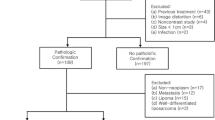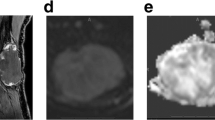Abstract
Purpose
To evaluate whether apparent diffusion coefficient (ADC) of diffusion-weighted imaging (DWI) is able to investigate the histological features of soft tissue tumours.
Methods
We reviewed MRIs of soft tissue tumours performed from 2012 to 2015 to calculate the average ADCs. We included 46 patients (27 male; mean age: 57 years, range 12–85 years) with histologically proven soft tissue tumours (10 benign, 2 intermediate 34 malignant) grouped into eight tumour type classes. An experienced pathologist assigned a semi-quantitative cellularity score (very high, high, medium and low) and tumour grading. The t test, ANOVA and linear regression were used to correlate ADC with clinicopathological data. Approximate receiver operating characteristic curves were created to predict possible uses of ADC to differentiate benign from malignant tumours.
Results
There was a significant difference (p < 0.01) in ADCs between these three groups excluding myxoid sarcomas. A significant difference was also evident between the tumour type classes (p < 0.001), grade II and III myxoid lesions (p < 0.05), tumour grading classes (p < 0.001) and cellularity scores classes (p < 0.001), with the lowest ADCs in the very high cellularity. While the linear regression analysis showed a significant relationship between ADC and tumour cellularity (r = 0.590, p ≤ 0.05) and grading (r = 0.437, p ≤ 0.05), no significant relationship was found with age, gender, tumour size and histological subtype. An optimal cut-off ADC value of 1.45 × 10−3 mm2/s with 76.8% accuracy was found to differentiate benign from malignant tumours.
Conclusions
DWI may offer adjunctive information about soft tissue tumours, but its clinical role is still to be defined.





Similar content being viewed by others
References
Mu-Koh D, Collins DJ (2007) Diffusion-weighted MRI in the body: applications and challenges in oncology. AJR 188:1622–1635
Tsushima Y, Takahashi-Taketomi A, Endo K (2009) Magnetic resonance (MR) differential diagnosis of breast tumours using apparent diffusion coefficient (ADC) on 1.5-T. J Magn Reson Imaging 30:249–255
Higano S, Yun X, Kurnabe T et al (2006) Malignant astrocytic tumours: clinical importance of apparent diffusion coefficient in prediction of grade and prognosis. Radiology 241:839–846
Bulakbasi N, Guvenc I, Onguru O et al (2004) The added value of the apparent diffusion coefficient to magnetic resonance imaging in the differentiation and grading of malignant brain tumours. J Comput Assist Tomogr 28:735–746
Schnapauff D, Zeile M, Niederhagen MB et al (2009) Diffusion-weighted echo-planar magnetic resonance imaging for the assessment of tumour cellularity in patients with soft-tissue sarcomas. J Magn Reson Imaging 29:1355–1359
Dudeck O, Zeile M, Pink D et al (2008) Diffusion-weighted magnetic resonance imaging allows monitoring of anticancer treatment effects in patients with soft-tissue sarcomas. J Magn Reson Imaging 27:1109–1113
Maeda M, Matsumine A, Kato H et al (2007) Soft-tissue tumours evaluated by line-scan diffusion-weighted imaging: influence of myxoid matrix on the apparent diffusion coefficient. J Magn Reson Imaging 25:1199–1204
Nagata S, Nishimura H, Uchida M et al (2008) Diffusion-weighted imaging of soft tissue tumours: usefulness of the apparent diffusion coefficient for differential diagnosis. Radiat Med 26:287–295
Einarsdóttir H, Karlsson M, Wejde J et al (2004) Diffusion-weighted MRI of soft tissue tumours. Eur Radiol 14:959–963
Lecouvet FE (2016) Whole-body MR imaging: musculoskeletal applications. Radiology 279:345–365
Albano D, La Grutta L, Grassedonio E, Patti C, Lagalla R, Midiri M et al (2016) Pitfalls in whole body MRI with diffusion weighted imaging performed on patients with lymphoma: what radiologists should know. Magn Res Imaging 34:922–931
Costa FM, Ferreira EC, Vianna EM (2011) Diffusion-weighted magnetic resonance imaging for the evaluation of musculoskeletal tumours. Magn Reson Imaging Clin N Am 19:159–180
Khoo MM, Tyler PA, Saiffudin A, Padhani AR (2011) Diffusion-weighted imaging (DWI) in musculoskeletal MRI: a critical review. Skelet Radiol 40:665–681
Fletcher C, Bridge J, Hogendoorn P et al (2013) WHO classification of tumours of soft tissue and bone. Pathology and genetics of soft tissues and bone. IARC Press, Lyon
Trojani M, Contesso G, Coindre JM et al (1984) Soft-tissue sarcoma of adults; study of pathological prognostic variables and definition of a histopathological grading system. Int J Cancer 33:37–42
Kransdrof MJ, Murphey MD (2000) Radiologic evaluation of soft-tissue masses: a current perspective. AJR 175:575–587
Hayashida Y, Hirai T, Morishita S et al (2006) Diffusion-weighted imaging of metastatic brain tumours: comparison with histologic type and tumour cellularity. Am J Neuroradiol 27:1419–1425
Albano D, Patti C, Lagalla R, Midiri M, Galia M (2016) Whole-body MRI, FDG-PET/CT, and bone marrow biopsy, for the assessment of bone marrow involvement in patients with newly diagnosed lymphoma. J Magn Reson Imaging. doi:10.1002/jmri.25439
Koh DM, Collins DJ (2007) Diffusion-weighted MRI in the body: applications and challenges in oncology. AJR Am J Roentgenol 188:1622–1635
Stecco A, Buemi F, Cassarà A, Matheoud R, Sacchetti GM, Arnulfo A, Brambilla M, Carriero A (2016) Comparison of retrospective PET and MRI-DWI (PET/MRI-DWI) image fusion with PET/CT and MRI-DWI in detection of cervical and endometrial cancer lymph node metastases. Radiol Med 121(7):537–545
Van Rijswijk CS, Kunz P, Hogendoorn PC et al (2002) Diffusion-weighted MRI in the characterization of soft-tissue tumours. J Magn Reson Imaging 15(3):302–307
Razek A, Nada N, Ghaniem M, Elkhamary S (2012) Assessment of soft tissue tumours of the extremities with diffusion echo planar Mr imaging. Radiol Med 117:96–101
Surov Nagata S, Razek AA, Tirumani SH, Wienke A, Kahn T (2015) Comparison of ADC values in different malignancies of the skeletal musculature: a multicentric analysis. Skelet Radiol 44:995–1000
Albano D, Patti C, La Grutta L, Agnello F, Grassedonio E, Mulè A et al (2016) Comparison between whole-body MRI with diffusion-weighted imaging and PET/CT in staging newly diagnosed FDG-avid lymphomas. Eur J Radiol 85:313–318
Galia M, Albano D, Narese D, Patti C, Chianca V, Di Pietto F et al (2016) Whole-body MRI in patients with lymphoma: collateral findings. Radiol Med 121:793–800
Teixeira PA, Beaumont M, Gabriela H et al (2015) Advanced techniques in musculoskeletal oncology: perfusion, diffusion, and spectroscopy. Semin Musculoskelet Radiol 19:463–474
Lee SY, Jee WH, Jung JY et al (2016) Differentiation of malignant from benign soft tissue tumours: use of additive qualitative and quantitative diffusion-weighted MR imaging to standard MR imaging at 3.0 T. Eur Radiol 26:743–754
Wu JS, Hochman MG (2009) Soft-tissue tumours and tumour like lesions: a systematic imaging approach. Radiology 253:297–316
Weiss SW, Goldblun JR (2001) Myxoid sarcoma. Enzinger and Weiss’s soft tissue tumours. Mosby, St. Louis, pp 150–156
Padhani AR, Liu G, Koh DM et al (2009) Diffusion-weighted magnetic resonance imaging as a cancer biomarker: consensus and recommendations. Neoplasia 11:102–125
Van Rijswijk CS, Kunz P, Hogendoorn PC, Taminiau AH, Doornbos J, Bloem JL (2002) Diffusion-weighted MRI in the characterization of soft-tissue tumours. J Magn Reson Imaging 15:302–307
Author information
Authors and Affiliations
Corresponding author
Ethics declarations
Conflict of interest
The authors declare that they have no conflict of interest.
Ethical approval
All procedures performed in studies involving human participants were in accordance with the ethical standards of the institutional and/or national research committee and with the 1964 Helsinki declaration and its later amendments or comparable ethical standards. For this type of study formal consent is not required.
Informed consent
Institutional review board approval was obtained for this retrospective study with a waiver of the requirement for informed consent.
Rights and permissions
About this article
Cite this article
Robba, T., Chianca, V., Albano, D. et al. Diffusion-weighted imaging for the cellularity assessment and matrix characterization of soft tissue tumour. Radiol med 122, 871–879 (2017). https://doi.org/10.1007/s11547-017-0787-x
Received:
Accepted:
Published:
Issue Date:
DOI: https://doi.org/10.1007/s11547-017-0787-x




